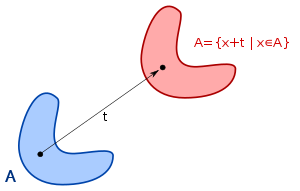Lebesgue measure
The Lebesgue measure [ ləˈbɛg ] (after Henri Léon Lebesgue ) is the measure in Euclidean space that assigns geometric objects their content (length, area, volume, ...). It is a special case of the Lebesgue-Stieltjes measure and is used to construct the Lebesgue integral .
background
From the point of view of modern mathematics, the Lebesgue measure is the natural term for surface area and volume. This concept is the end product of a whole series of ideas that tried to make mathematical terms such as area and volume precise. This process can only be considered complete with the Lebesgue measure. The Lebesgue measure not only assigns a content to simple geometric objects, but also to much more general sets including all open and closed sets. The existence of non-Lebesgue-measurable sets (such as the Vitali sets ) can be proven non-constructively using the axiom of choice .
definition
The Lebesgue- Borel measure on the Borel σ-algebra (also referred to as the Borel-Lebesgue measure or just Borel measure ) is the unique measure with the property that it assigns -dimensional hyperrectangles to their -dimensional volume :
- .
That is, it is the measure that assigns length to intervals (in one-dimensional), assigns rectangles to their area (in two-dimensional), assigns volume to cuboids (in three-dimensional) etc. This condition clearly defines the content of any Borel set. The Borel quantities are also called Borel-measurable or B-measurable . The Borel measure is motion-invariant and normalized, but not complete . The existence of the Lebesgue-Borel measure was first proven in one-dimensional by Émile Borel in 1895, a more modern construction using the measure extension theorem goes back to Constantin Carathéodory (1918).
The Lebesgue measure is the complete measure that is obtained from this measure if one adds to all the quantities that lie between two Borel sets ( ), which have the same content, more precisely , and so specify. The sets for which the Lebesgue measure is defined in this way are called Lebesgue-measurable (or L-measurable ) and form the Lebesgue algebra .
B-measurable and L-measurable
It can be shown that the amount of L-measurable amounts is much larger than the amount of B-measurable amounts:
where stands for cardinality and for the power set of a set.
Zero quantities
Sets with a Lebesgue measure equal to 0 are called Lebesgue null sets . Countable quantities such as B. the set of rational numbers are Lebesgue null sets. An example of an uncountable Lebesgue null set is the Cantor discontinuum . If a mathematical statement applies to an area with the exception of a Lebesgue null set within the area, then one says: The statement applies Lebesgue almost everywhere .
properties
The Lebesgue measure is the hair measure on the locally compact topological group with addition , the existence therefore already follows from the existence of the hair measure. In particular, it is translation-invariant , which means that the measure of a set does not change under translation . In addition, it is invariant under reflections and rotations , i.e. even motion-invariant . The Lebesgue measure is σ-finite and regular .
Characterization of Lebesgue measurability
A subset of is Lebesgue measurable if and only if it has the following characteristic property :
- At any given barrier there in always a open set and a closed set with
- and .
Construction of the Lebesgue measure
One possible definition of the Lebesgue measure is the construction of Carathéodory . Let be the set of dyadic unit cells and the volume of ; since these quantities only consist of products of intervals, the volume is simply defined as the product of the individual side lengths. is a half-ring and a finite content , i.e. a premeasure . This pre-measure is also called the Lebesgue pre-measure . According to Carathéodory's measure extension theorem , it can be extended to a measure on the generated algebra, which is precisely the Borel sets. This continuation is the Lebesgue-Borel measure.
Specifically, the proof can be carried out as follows (the proof of the general measure extension theorem is analogous in the essential points): For a given set one defines
- .
The function is defined on the entire power set and is a metric outer measure , but not a measure . In order to get a measure, one can switch from the power set to a smaller set system as follows.
A lot can be measured if the following applies to all :
(see Measurability according to Carathéodory ).
All measurable quantities from form a σ-algebra and then a measure , i.e. i.e., is a measure.
See also
Sources and further information
- ↑ Norbert Kusolitsch: Measure and probability theory . An introduction. 2nd, revised and expanded edition. Springer-Verlag, Berlin Heidelberg 2014, ISBN 978-3-642-45386-1 , p. 68 , doi : 10.1007 / 978-3-642-45387-8 .
- ^ Olav Kallenberg : Foundations of Modern Probability. 2nd edition. Springer, New York NY et al. 2002, ISBN 0-387-95313-2 , p. 570.
- ↑ Michael Leinert : Integration and Measure. Vieweg, Braunschweig et al. 1995, ISBN 3-528-06385-8 , 4.20.
- ↑ Examples of non-B-measurable L-measurable quantities were given for the first time by Suslin. He developed the system of so-called analytical sets , which is a real extension of the system of Borel sets and is completely in the system of L-measurable sets.
- ↑ The Cantor discontinuum is also a Borel null set. Since the Lebesgue measure is complete, all subsets of the Cantor discontinuum are L-measurable. From this follows the first of the above-mentioned inequalities - namely that the system of L-measurable sets is really more powerful than the continuum .
- ↑ Jürgen Elstrodt : Measure and integration theory. , 7th, corrected and updated, Springer, Heidelberg et al. 2011, ISBN 978-3-642-17904-4 , p. 67.



![{\ displaystyle \ lambda ([a_ {1}, b_ {1}] \ times \ dotsb \ times [a_ {n}, b_ {n}]) = (b_ {1} -a_ {1}) \ cdot \ ldots \ cdot (b_ {n} -a_ {n})}](https://wikimedia.org/api/rest_v1/media/math/render/svg/7db117ee1c6eab6b1879a562fbe45161e8007bde)






























